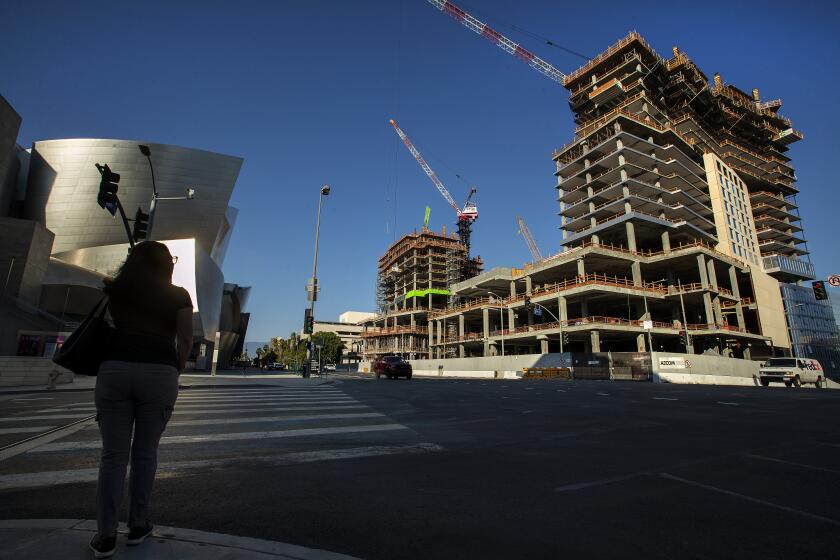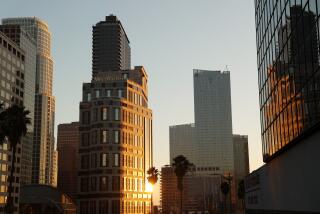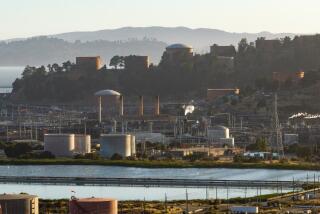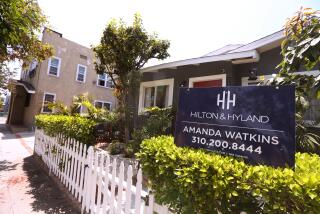Beyond Meat signs a big lease. The rest of L.A.’s office market struggles
- Share via
Demand to rent offices has withered, fresh data show, as the pandemic has left Los Angeles County business owners wondering when employees will be able to return.
Office lease signings have fallen since March, when fear of COVID-19 forced many companies to send staff members home, to work remotely or to receive unemployment assistance. Overall vacancy climbed to nearly 16% in the final three months of 2020, according to real estate brokerage CBRE. The losses capped the worst year for office leasing since the Great Recession.
Managers are putting off moves as they wait to see how quickly the economy will recover and how their space needs might change after vaccines bring an end to the pandemic and people are willing to work together again.
“Decision makers are saying, ‘Hey, let’s wait until we know what the future is going to look like when we get back in the office and we are more comfortable making long-term decisions,’” broker Jeff Pion of CBRE said.
A hot spot in the stale leasing market is El Segundo, where Beyond Meat Inc., a producer of plant-based meat substitutes, just agreed to rent offices that are being created in a former airplane manufacturing plant for use as its headquarters.
Beyond Meat and Los Angeles landlord and developer Hackman Capital Partners said Friday that the company will lease 280,000 square feet at 888 N. Douglas St. The 12-year lease is valued at more than $178 million, according to Beyond Meat’s filing Friday with the Securities and Exchange Commission, easily one of the largest deals signed in the Los Angeles region since the pandemic began.
The move, set for the fall, will be an expansion for Beyond Meat, which was founded in 2009 in El Segundo, where it has modest offices in a two-story building near Main Street. The company went public in 2019 and has become one of the largest makers of meat substitutes that include Beyond Beef and Beyond Sausage.
The new headquarters will give Beyond Meat room to research and develop new technologies and product lines while quadrupling its staff, according to the company and Hackman.
The developer has been working on 888 N. Douglas St. since 2017, in a makeover valued at more than $100 million. The oldest of the four buildings on the site, the one that will be occupied by Beyond Meat, was completed in 1930 as a bus manufacturing plant for Pickwick Stage Co., a California operator that became part of Greyhound Lines. It was later used for making airplanes, including World War II dive bombers produced by Douglas Aircraft Co.
The 390,000-square-foot building has 50-foot ceilings and an airy, industrial sensibility that makes it the kind of offbeat office environment long sought by companies in creative fields and becoming popular with more mainstream firms. French cosmetics company L’Oréal is widely expected to lease another space at 888 N. Douglas St.; Hackman declined to discuss prospective tenants.
In a downtown missing its office workers, tourists and museum visitors, work on the Frank Gehry-designed $1-billion Grand complex reaches the halfway point.
The South Bay real estate market, which includes El Segundo, was one of the few in Los Angeles County that gained more rented office space than it lost in the fourth quarter, CBRE said. Among the largest deals was an agreement for Fisker Inc., a maker of electric cars, to take 72,000 square feet in Manhattan Beach.
The South Bay has shed its longtime dependence on the defense industry and no longer rises and falls in tandem with office districts in L.A.’s Westside, said Pion, who helped arrange the Beyond Meat lease.
“The South Bay has emerged as a stand-alone popular market,” he said.
Pion attributed its popularity in part to shifts in attitude in recent years among executives, who have concluded that they no longer need to keep their companies in traditional business centers such as Century City and downtown Los Angeles and have set up shop near the increasingly upscale neighborhoods along the coast, from Rancho Palos Verdes north to El Segundo.
The West L.A. market, which includes Santa Monica, remains one of the most desirable office markets in Southern California but has seen one of the largest jumps in vacancy, with a net occupancy loss of nearly 1 million square feet in the fourth quarter.
CBRE attributed that in part to the area’s large share of small companies in tech and entertainment. Small companies run by a few decision makers can be nimble, and many contracted quickly when faced with the pandemic, said Eric Willett, CBRE’s regional director of research.
“Those have been the tenants that have been the most mobile in the face of this current crisis,” he said, noting that many chose to sublease space they couldn’t use or to walk away rather than renew leases that expired.
How companies will want their offices to look when they return from the pandemic is unclear, but Willett doesn’t predict a big drop in the use of space. CBRE clients “are stepping back from this work-from-home experiment,” he said, and not conducting wholesale reevaluations of their office needs.
Employees will work from home more often, but that won’t dramatically reduce companies’ office requirements, he said: “If you work at home one day out of five, you don’t need 20% less office space.”
Despite the economic head winds, the average asking price for rents sought by Los Angeles landlords in the fourth quarter climbed slightly, reflecting the availability of higher-quality space and a general reluctance by landlords to drop prices, CBRE said.
In order to compete for the reduced number of tenants in the market, landlords are offering other inducements, such as months of free rent and generous allowances for tenants to build out offices the way they like.
Beyond Meat, for instance, received a year of free rent and an allowance of $100 per square foot to improve its offices, according to the company’s SEC filing.
During the roughest four quarters for office leasing amid the Great Recession — the global downturn that began in the U.S. in December 2007 and ended in June 2009 — Los Angeles County landlords lost 5.7 million square feet of occupied space. But 2020 was worse, with a drop in occupancy of nearly 6.7 million square feet.
However, when the pandemic hit, the market was in better shape than it was before the recession, Willett said, so recovery should be faster this time.
“Given the balanced supply-and-demand factors entering the pandemic, we expect the rebound in this current environment to be much quicker,” he said.
Overall office vacancy in Los Angeles County was 15.9% in the fourth quarter, up from 15.1% in the previous quarter and 12.3% in 2019’s fourth quarter. Rents sought by landlords for the most desirable spaces, known as Class A, averaged $4.14 per square foot per month, up from $3.97 in the third quarter and $3.78 in 2019’s fourth quarter.
More to Read
Inside the business of entertainment
The Wide Shot brings you news, analysis and insights on everything from streaming wars to production — and what it all means for the future.
You may occasionally receive promotional content from the Los Angeles Times.












